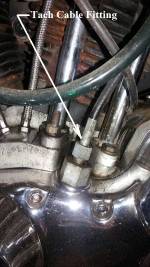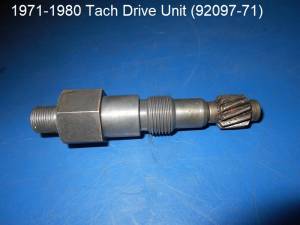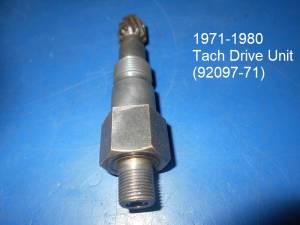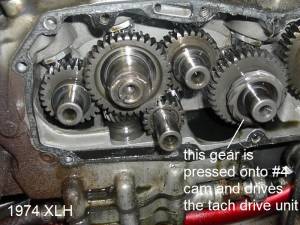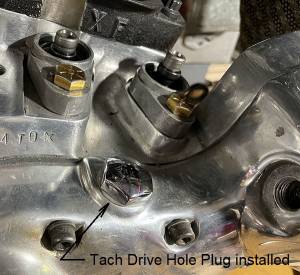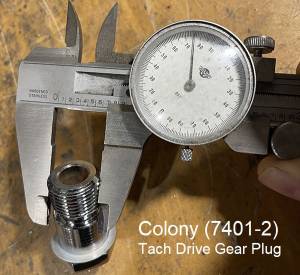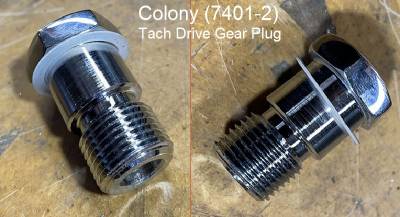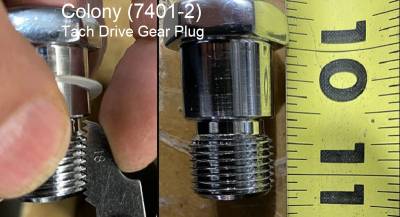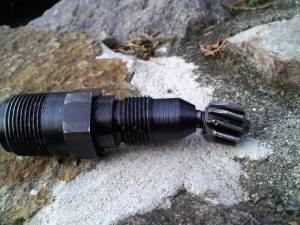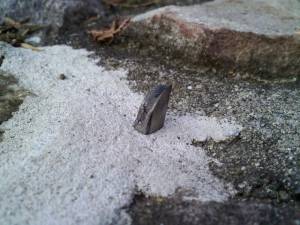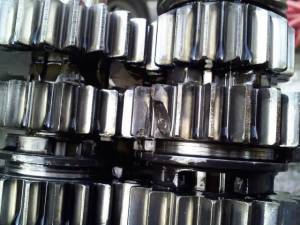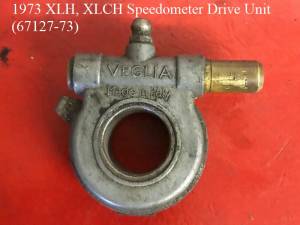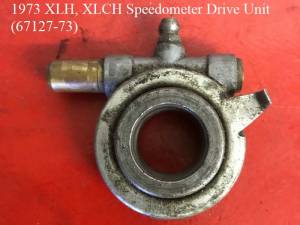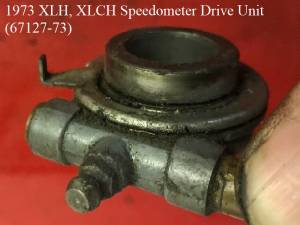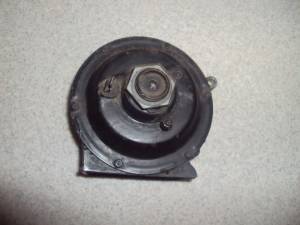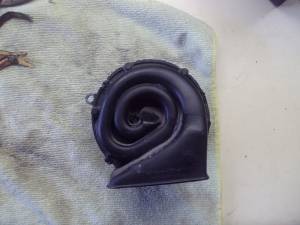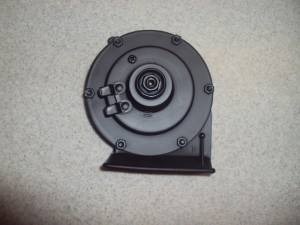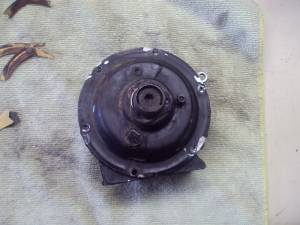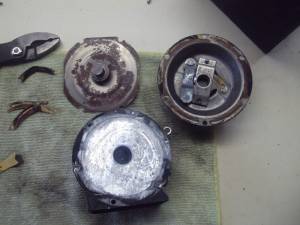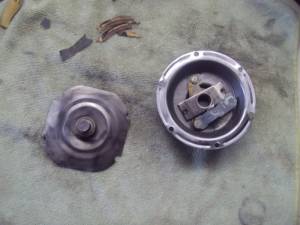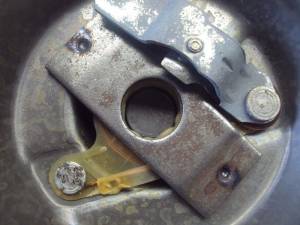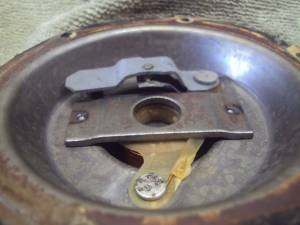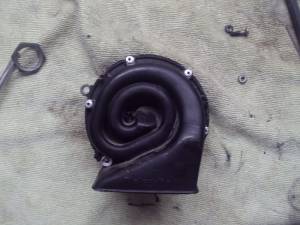Table of Contents
This is an old revision of the document!
IH: Electrical System
SWITCHES
Keyswitch
The Keyswitch is fed from the main Circuit Breaker. Typically, this feed wire is RED. The Keyswitch has two positions (besides OFF).
There is a RUN position & a LIGHTS position. This allows the lights to be off for starting (especially kick starting) but then can be turned on by moving the keyswitch to the second on position. But sometime in the late 70's, the MoCo began putting a shorting wire across both output connections of the Keyswitch. This meant that all the circuits are powered whenever the Keyswitch is ON, so that the lights are guaranteed to be on (basically making the keyswitch simply an ON/OFF switch). The Keyswitch labels were likely to be B - IG - L for Battery, Ignition & Lights.
Brake Switch
 |
|||||||
|---|---|---|---|---|---|---|---|
| Front and Rear Brake Switches | |||||||
| Year Model | Position | Switch Part# | Additional | Year Model | Position | Switch Part# | Additional |
| 1959-1966 | Rear | 72004-52 | Complete | 1973-1981 | Front | 72001-69B | Switch only |
| 1967-1972 | Rear | 72004-67 | Kit with wires | 1977-1978 | Rear | ||
| L1969-1972 | Front | 71900-70 | Includes terminal | 1979-1985 | Rear | 72023-51A | Switch only |
| 1973-1974 | Rear | 72004-70 | Switch only | 1982-1985 | Front | 71574-82 | Includes terminal and wiring |
| 1975-1976 | Rear | 72004-75 | Switch only | ||||
The stock 77 rear brake light switch is a cheesy little thing that attaches to the pressed metal inner sprocket cover/brake cable mounting plate under the aluminum sprocket cover. 1) They are tiny and often get clogged up with chain gunk in there. The little flat plate sticking out from the end of the cable operates it. It mounts on a right angle metal bracket going to the quarter nut and stud above, allowing adjusment.
Rear Brake Switch (72001-69B) on 1977 XLCH.
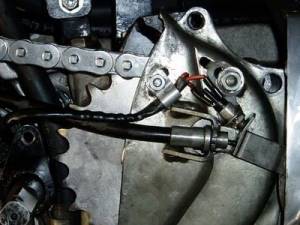 2)
2)
INSTRUMENTS
Sub Documents
Speedometers
All Ironhead Sportster speedos, whether tranny driven or front wheel driven, are 2:1 ratio.
1957-72 - Transmission Driven - 2:1 Ratio Speedometers
1973-83 - 19“ Wheel Driven Right Side - 2:1 Ratio Speedometers 3)
1984-85 - 19” Wheel Driven Left Side - 2:1 Ratio Speedometers
. Driven Unit = 67127-84A for use with 2:1 Speedometers - (CableRPM-2000=60mphOnSpeedo)
 |
||||||
|---|---|---|---|---|---|---|
| Speedometers for Sportsters / K Models with gradients in MPH | Speedometers for Sportsters and K Models with gradients in KPH |
|||||
| All K Models | 1952-1954 | 67007-52 | KH / XL / XLH | 1954-1958 | 67008-52 | |
| 67007-54 Replaced 67007-52 | XLH & XLCH | 1959-1967 | 67008-59 | |||
| KH models Sportsters (except C & CH) | 1955-1958 1957-1958 | 67007-54A | 67008-59A | 1968 Replacement part for 1959-1967 | XLH & XLCH | |
| XLH & XLCH | 1959-1964 | 67007-59 | 1969 Replacement part for 1959-1968 | 67008-59B | ||
| 1965-E1967 | 67007-59A | 1970-1972 | 67021-70 | |||
| L1967-1968 | 67007-59B | 1973 | 67021-73A | |||
| 1969 | 67007-59C | 1974-1976 | 67043-74A | |||
| 1970-1973 | 67020-70 | 1977-1979 Replacement for 1974-1976 | 67043-74B | |||
| 1973 | 67020-73B | XL XLS | 1980-1983 1981-1982 | 67043-75C | ||
| 1974-1976 | 67020-74A | |||||
| 1977 Replacement for 1974-1976 | 67020-74B | |||||
| 1978 Replacement for 1974-1978 | 67020-75D | |||||
| XL & XLCH | 1979 | 67020-74B | ||||
| XL XLS | 1980-1983 1981-1982 | 67020-75D | ||||
| XLS | 1983-1984 | 67100-83 | ||||
| 1985 | 67100-85 | |||||
| XLX | 1983-1984 | 67016-83 | ||||
| 1985 | 67016-85 | |||||
Tachometers
| XLCH | L1962-1964 | 92051-62 |
| XLCH Late XLH | 1965 | 92051-65 |
Tach Drive Gear (1971-1980)
If you are not using the tach, you can remove the drive unit from the cam cover and plug it using something like this Colony plug.
Speedometer Drive Gear
1952-1972
The mechanical speedometer on K Models / XLH from 1952-1972 and XLCH from 1959-1972 is run by a (11T) gear unit attached to the transmission.
This was not used on 1958 XLC or XLCH.
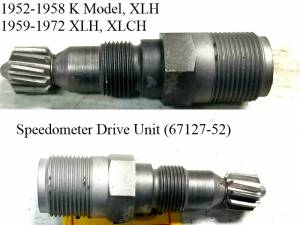 12)
12) 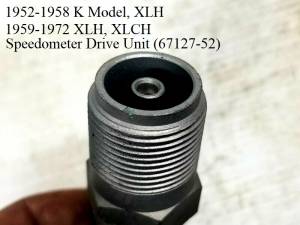 13)
13)
The speedometer drive unit goes into the hole in the lower right side of the transmission beside the oil pump.
The pic on the right shows the drive unit as installed from the inside.
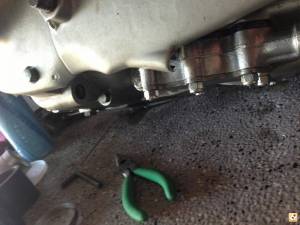 14)
14) 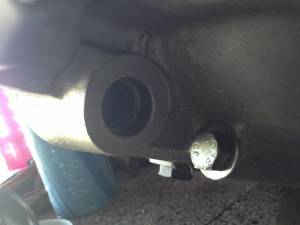 15)
15) 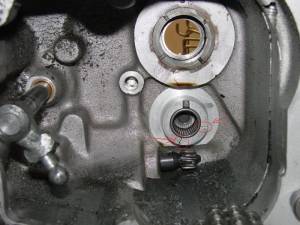 16)
16)
Staring down a problem with the speedometer not working can be catastrophic when visualizing the possible causes and particularly the effects thereof.
Also, if you're not going to use the OEM speedo drive, then remove it and plug the hole. That freewheeling drive has been known to destroy the trans and engine case. 17)
Just unscrew it and screw in a plug. Colony makes a Speedometer Drive Block-Off Plug (2057-2) for K Models and XLs.
1973
The speedometer drive unit was moved to the front wheel, right side, in 1973. 1970-1973 XLH, XLCH used Veglia (Italian made) instruments.
And the 73 drive unit (67127-73) was also from Veglia. In 1974, the MoCo started using Nippon Seiki (Japan) gauges and drive units.
The new drive unit didn't have the grease fitting as did the 73 unit but has the same part number as in 73, and retrofitting to 73 models for replacement.
LIGHTS
Headlight
In Late 1977, Shorter Headlight Bracket Mounting Bolts Used
- In late 1977, shorter bolts were used to mount the headlight bracket to allow it to be installed or removed with the handlebars clamped in place. The shorter bolt also allows for the mounting of the headlight bracket after mounting the speedometer / tachometer bracket underneath the handlebar upper clamp which provides easy access to the wiring connections at the headlight terminal block.
- The shorter bolts 5/16“x18 1-1/8” (43868-72) replaced the longer 5/16“x18 1-1/4” bolts (2871W). The longer bolts can also be shortened for this application. 24)
Taillight - License Light
Turn Signals
(1973-85 Simple Turn Signal Function)
These model years HD implemented a basic turn signal circuit using a bi-metallic, current/heat-controlled, Turn Signal Flasher Unit similar to those in automobiles. The 12v power wire feeds thru the Flasher and then goes to the handlebar switches. The Left or Right handlebar turn signal switch could be pressed to feed the power to the bulbs on that side of the bike. When connected to the bulbs, thus completing the circuit, the Flasher unit would supply power until the current flowing through it would heat the bi-metallic elements sufficiently to cause a break (like a circuit breaker) in the circuit. Once the flasher cooled down, the bi-metallic elements would again conduct power to the turn signal bulbs, thus causing an on-off cycle that repeated until the handlebar switch was released.
From 1973-1981, the handlebar TS switches were small pushbuttons. They were momentary contact. The turn signal only stayed flashing while the button was depressed.
From 1982-1985, the handlebar TS housings were changed, creating a larger TS button. The switches were still momentary contact, working only while the button was depressed.
- (Converting to LEDs) - Because of the way these bikes were wired, you can replace the single current/heat-activated flasher with a new electronic flasher that is capable of properly flashing LEDs or Incandescent bulbs. However, the indicator light may need to be modified by grounding one side and feeding power from the right and left circuits thru diodes to the power side of the indicator.
Signal-STAT Flashers
From a bulletin in 1961:
Different flasher modules have different characteristics. It is important to use the appropriate one when replacing them. For instance:
- Flasher (68543-61) was originally used for directional signals with 21 candlepower to the front and rear lamps (6872-50) and 1 candlepower pilot lamps (71090-47). If any of the signal bulbs burn out, the pilot lamp in the same circuit will remain on.25) Flasher (68543-61A) was the replacement for directional signals. 26)
- Flasher (68542-61) is used for pursuit lamps or other flashing lamps which use either one or two 32 candlepower lamps (68715-49).27)
| Year model | Part # | Used For | Markings | Application Voltage | Notes |
| 1957-E1963 | 68543-61 | Directional signals | N 221-6V | 6 | 3-prongs: X (hot), L (switched), P (not used) |
| 1957-1965 | 68543-61A | Directional signals | 143-12V | 6 | Replaced 68543-61 in L1963. Disregard the 12V markings per HD. 2 prongs: X (hot), L (switched) |
| 68542-61 | Pursuit lamps | F 421-6V | 6 |
Horn
There was a truck load of changes in the horn mounts between late 1970 till 1975. 28)
The changes weren't really cataloged in the part books.
Basically:
1965-1970 all used the same geometry.
1965 and 1966 used different stuff than 67> but the end result was same.
And this 1st gen stuff was used on some 1971's, maybe even some 72's also.
This set up used the larger diameter, short, stiff, 5/16“ stud rubber mount.
It held the horn way more solid than the later smaller, longer, 1/4” stud rubber mount.
Both 1st gen brackets had less inward offset than any of the later ones.
The shananigans began in late 1970 with the intro of the 'low' seat kit.
1971 and maybe the 1972 bikes that came from the factory using the older standard seats supposedly came with the 1st gen 65-70 setup.
In late 1971, the low seat was available factory installed for the 1st time.
The low seat required the ignition switch to be moved from the right side under the high seat to the left side on top motor mount where it fouled the horn brackets.
At first, the new brackets with deeper offsets that opened up room for switch were supplied that used the old 5/16“ rubber.
There were some issues with interference. The smaller rubber mount and another set of new brackets were furnished to solve that issue.
But the 1/4” rubber mount let the horn flop around to much hitting fins and/or shaking the wire loose from the slip-on terminal.
The bumper was the fix for this. This 3rd gen setup was used till 1974.
In 1975, a bigger ignition switch was used. New brackets again, 4th gen.
There are so many different brackets used that having mismatched stuff is common changing horn position to who knows where.
Below is a rebuild of the stock Delco Remy horn from a 68 XLCH. 29)
There are horn rebuild kits available, but they are pretty simple in design and a good cleaning may be all that is needed.
The repop one from J&P Cycles is on the right (3rd pic below). It has 2 wire connections as opposed to the single wire connection on the original horn.
A bench grinder was used to grind the rivet faces off flat. You can also use a drill bit that is larger than the hole in the rivets to drill off the face.
Then you can use a center punch to knock the rivets out or pull them out of the other side with pliers.
Then separate the halves and clean up all surfaces with sand paper or a wire wheel.
You can check the continuity of the coil but be careful not to break the wire.
Use some 400 grit sand paper to lightly resurface the contact points (you may have to push the lower contact down to get the sandpaper in and out).
After everything is cleaned up, reassemble the horn and test.
There is a small screw on the back of the horn, you can make slight turns on it to adjust the horn for the best sound.
Keep in mind that too far one way or the other and the horn will not work at all. Use pop rivets to put the horn back together after a thin coat of RTV.
Ensure that you don't get any sealant on the vibrating plate or it will not work.

